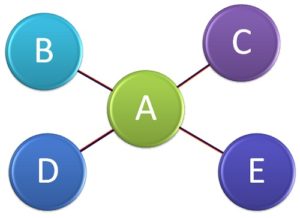An organisation can be described as the network of communication channels. These channels can be either intentionally designed, or they may develop of their own accord.
Type of Communication Channels
When a channel is intentionally created for the flow of communication in the Organisation, it is called a formal channel. The communication passing through a formal channel is formal communication. On the other hand, channels, outside the formal channels, are referred to as informal channels. The communication through informal channels is informal communication.
Formal Communication Channels
An organisation chart shows the direction of formal communication flow in an organisation. It identifies
the various transmitters and receivers, and the channels through which they must communicate. formal communication may take place between one division of an organisation and another. There are four networks of formal communication:
- Wheel Network: The ‘wheel’ or ‘star’ represents an administrator and four subordinates with whom he or she interacts. There is no interaction among the subordinates.

- Y Network: In the ‘Y’ network two subordinates report to the superior. It may be regarded as a four-level hierarchy.

- Chain Network: The ‘chain’ can represent a five-level hierarchy, in which communication can take place only upward and downward, and across organisational lines.

- Circle Network: The ‘circle’ network represents a three-level hierarchy in which there is communication between superiors and subordinates, with cross communication at the operative level

‘Y’ and ‘star’ networks are highly centralised, with chain occupying the central position. The ‘circle’ and ‘chain’ networks were found to be decentralised with no member being able to influence all other members
Informal Communication Channels
Communication that takes place without following the formal lines of communication is said to be informal communication. This channel is not created by management and is usually not under the control of management. An informal system of communication is generally referred to as the ‘grapevine’ because it spreads throughout the organisation with its branches going out in all directions in utter disregard of the levels of authority and linking members of the organisation in any direction.
The informal communication arises as a result of employee needs for information which are not met by the formal channels. It has been observed that problems relating to work and unfavourable reactions to various organisational practices are transmitted through information communication. Since the channels are flexible and establish contacts at personal levels among members of the organisation at different hierarchical levels, the grapevine spreads information faster than the formal system of communication.

In contrast to the formal communication which moves on slowly from one person at one hierarchical level to another at the next hierarchical level, the grapevine transmits information from one person to a group of persons much more rapidly in a cluster chain management. Each individual passes the information to several others, some of whom repeat the message to others.
The manager’s responsibility, therefore, lies in utilising the positive aspects of the informal channels of communication and in minimising the negative aspects of this channel.
We hope you liked this article on Communication Channels. Here are few useful articles for you to read next:
Download this article as PDF
Click to go to RBI Grade B Preparation Page
Tags: channels of communication, informal communication, various channels of communication, channels of communication in an organization, types of communication channels, formal communication